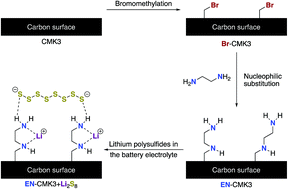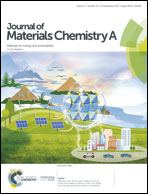Bromomethylation of high-surface area carbons as a versatile synthon: adjusting the electrode–electrolyte interface in lithium–sulfur batteries†
Abstract
A two-step procedure for the surface functionalization of carbon materials has been developed. In the first step, mesoporous carbon (CMK3), carbon black (XC-72R Vulcan), and activated carbon (AC) are bromomethylated efficiently under mild conditions using commercially available reagents, resulting in reproducible surface bromine loadings, the concentrations of which correlate to the carbon's surface area. The resulting bromomethylated materials display excellent stability over the course of months when stored under ambient conditions. In the second step, substitution reactions with a variety of nucleophiles proceed efficiently. Example nucleophiles include azide, amines, ammonia and iodide, and exhibit high conversion yields. To demonstrate the application of this two-step functionalization method, bromomethylated CMK3, Br-CMK3, was reacted with ethylenediamine (EN) to form EN-CMK3, which was used as the conductive host for the sulfur cathode in lithium–sulfur (Li–S) batteries. Impregnation of EN-CMK3 with a lithium polysulfide-containing electrolyte with either lithium nitrate (LiNO3) or lithium bis(trifluoromethanesulfonyl)imide (LiTFSI) as the supporting electrolyte increases the battery performance relative to pristine CMK3. With LiNO3, the surface-bonded EN allows for increased sulfur use and results in higher capacities of ca. 300 mA h g−1; with LiTFSI, the EN groups attenuate the polysulfide shuttle (LiPS shuttle) and the initial charging efficiency (ICE) is increased substantially from 3% to 73%. These results provide a proof-of-principle of the versatility of bromomethylated carbons as a useful starting material for a variety of functional materials.



 Please wait while we load your content...
Please wait while we load your content...